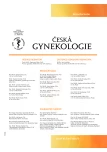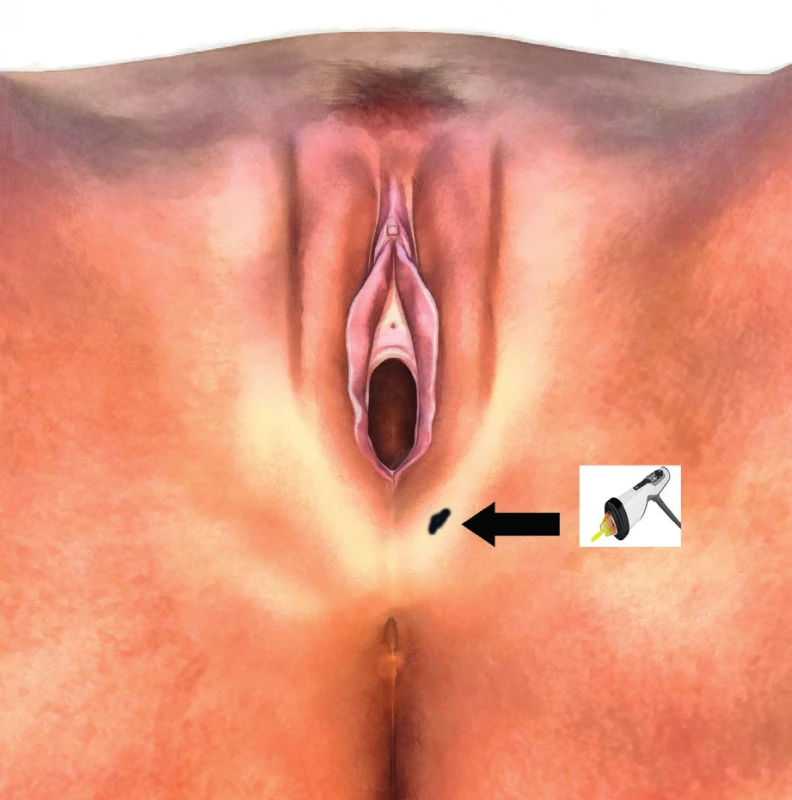Extracorporeal shock wave therapy for trigger point induced pain after peri-neal injury
Extrakorporeální rázová vlna v terapii indukované bolesti po perineálním poranění
Cíl práce: Cyklistika je velmi populární formou rekreace, cvičení a způsobem dopravy. Je však také spojena s rizikem zranění a nehod. Některá zranění rezultují v dlouhotrvající, často permanentní bolest vycházející z oblasti spouštěcích bodů (trigger-point). Extrakorporální terapie rázovou vlnou je jednoduchá, bezpečná, moderní a slibná metoda odstranění bolesti. Použití relativně slabé, neinvazivní energie rázové vlny je úspěšně užíváno v mnoha oborech medicíny. Autoři prezentují, podle našeho názoru, významný případ tohoto druhu.
Typ studie: Přehled problematiky a kazuistika.
Název a sídlo pracoviště: Klinika gynekologie a porodnictví 1. LF UK, Bulovka, Praha, Gynekologicko-porodnické pracoviště Amedeana, Praha.
Metodika: Evaluace literatury a vlastní studie.
Závěr: Malá zranění mohou někdy vyústit v problémy ve větších oblastech těla. Bolest vycházející ze spouštěcích bodů je jedním z těchto problémů. V našem sdělení jsme stručně popsali užití extrakorporeální rázové vlny u naší pacientky po perineálním sportovním úraze.
Klíčová slova:
extrakorporeální rázová vlna – trauma – spouštěcí bod – bolest
Authors:
K. Hurt 1; I. Rakovičová 2
Authors‘ workplace:
Department of OBGYN, 1st Faculty of Medicine, Charles University Prague, Bulovka Teaching Hospital, head, prof. Zikán M., MD, PhD
1; Amedeana OBGYN dpt. Prague, head Rakovičová I., MD
2
Published in:
Ceska Gynekol 2020; 85(5): 325-326
Category:
Overview
Objective: Bicycling is a popular form of recreation, exercise and mode of transportation. It also carries along with it the risk of injuries and accidents. Some injuries are followed with long-lasting pain emanating from trigger point locations. Extracorporeal shock wave therapy is a simple, safe, modern and promising pain-killing option. A weaker, noninvasive energy source of shock wave has been successfully used in many fields of medicine. The authors report a noteworthy case of this kind.
Design: Literature overview and case report.
Setting: Department of Obstetrics and Gynaecology 1st Faculty of UK, Bulovka Hospital, Prague; Amedeana obgyn dpt. Prague.
Methods: Evaluation of the literature and an observational study.
Conclusion: A minor injury could sometimes result in problems in larger body areas. Trigger-point induced pains represent cases of this sort. We briefly described aspects of possible shock-wave-treatment-use in our patient after a perineal area sport injury.
Keywords:
trauma – Pain
INTRODUCTION
Bicycling is a popular form of recreation, exercise and mode of transportation. However, it also carries along with it the risk of injuries and accidents [5]. Injuries associated with cycling can be classified into two main groups: physical trauma and injuries due to overuse [14]. The most acute physical traumas result from collisions with other vehicles and include head, spinal cord and musculoskeletal injuries. Overuse injuries consist of neck and back pain as well as pain and discomfort in the upper and lower extremities [12]. Some injuries can result from the bicycle itself especially from a saddle or handlebar [8].
Extracorporeal shock wave therapy (ESWT) is a simple, safe, modern and promising pain-killing option that could be used to attenuate the pain linked to musculotendinous injuries [10, 17]. A weaker, noninvasive energy source of ESWT has been successfully used in the orthopedic field to treat degenerative and painful joint disorders, plantar fasciitis and muscle disorders [1, 7, 9]. Because of these promising results, we elected to treat our patient with ESWT. Even a clinically relevant pain reduction would be an acceptable outcome of treatment.
CASE REPORT
We were contacted by a 32-year-old female patient who had a bicycle accident 1.5 years before contacting our clinic. The patient reported that she was injured by the handlebar of her bicycle during a fall from the vehicle. She received a 3-cm long tear in her left perineal area, which was sutured shortly after her accident at the local surgery. Shortly after recovery she experienced stitching pain emanating from an injury to the radial area. The pain could be characterized as continuous, especially increasing in stillstand. The patient was asked to evaluate pain intensity on a 6-point visual analog scale (VAS, 0 = no pain, 5 = maximum pain). Her evaluation was 4. The character of the pain and how it spreads were typical trigger-point (TrP) characteristics. The patient had undergone a number of treatments without long-lasting effects. Upon request of the patient and with her written consent, we concluded that it was safe and effective to start the treatment with ESWT. On an expected TrP, which was in the areas of her injury, we applied ESWT treatment twice weekly, delivering 3000 pulses in each session for four consecutive weeks (Fig. 1). The energy flux density was 0.35 mJouls/mm2, frequency 4 Hz, focus zone 0–30 mm, therapeutic efficiency 0–90 mm and shockwave stand-off II, DUOLITH® SD1, Storz Medical, Taegerwilen, Switzerland. Even after the first week, the patient reported a significant improvement, which was especially expressed after the final treatment. During the follow-up periods of 1, 4 and 12 weeks post-ESWT, the patient reported her subjective satisfaction with the treatment (pain intensity score ranging from 0–1 on the VAS). The patient gave written informed consent to publish the medical data related to her case.
DISCUSSION
Pain treatment connected to focal injuries is often a long-term endeavor. Many authors suggest that TrPs derive from damaged nerve endings. Finding a suitable method is often a prominent challenge.
ESWT-induced hyperstimulation of nociceptors and changes in brain patterns may play a vital role in musculotendinous pain treatment [2]. Several authors propose that ESWT interrupts nerve pulse hyperstimulated conduction [16]. An autonomous nervous system and the coordination between smooth and cross-striated muscles are thought to be involved in a structure change during shock wave treatment [15, 16]. Several studies have reported the stimulation of growth factors and the promotion and formation of new blood vessels (angiogenesis) [3, 4]. Several orthopedic and urological investigations reported no side effects of ESWT treatment [7, 11].
The high tolerability of ESWT and the ability to apply shock waves without anesthesia permit evaluation without any risks to the patient. Incidentally, anesthesia is not recommended before the introduction of ESWT because of the significant killing of all positive outputs [11]. Even knowing that the effect of ESWT treatment is dose-dependent, we did not exceed the 0.35 mJouls/mm2 level because of potential pain intolerance caused by the ESWT application. Still, the treatment effect appeared to be suitable [6, 13, 17]. Another positive finding is that there were no side effects (e.g., bleeding, hematoma, bruising, blistering) associated with the ESWT treatment. The strengths of this treatment are its relative simplicity and reproducibility in other settings.
For two reasons, we argue for the relevance of the present case. First, ESWT could successfully be used for the treatment of tissue-pain even in the perineal area. Second, TrP theory may play an important role in pain management.
CONCLUSIONS
Treating long-lasting pain after injuries is often a challenging and difficult task. A relatively minor injury could result in problems in larger body areas. We briefly described the use of ESWT in clinical medicine and its possible use in the field of obstetrics and gynecology. In our case report we described the successful treatment of a female patient with focal pain stemming from a previous minor injury. Further discussion about the role of TrPs is warranted.
Karel Hurt, MD, PhD
Department of OBGYN
Charles University Prague
Bulovka Teaching Hospital
Budinova 2
180 00 Prague 8
Czech Republic
email: hurt@prahainfo.com
Sources
1. Ciampa, AR., de Prati, AC., Amelio, E., et al. Nitric oxide mediates anti-inflammatory action of extracorporeal shock waves. Febs Letters, 2005, 579(30), p. 6839–6845. doi: 10.1016/j.febslet.2005.11.023. PubMed PMID: WOS:000234130000025.
2. Daliri, SS., Forogh, B., Razavi, SZE., et al. A single blind, clinical trial to investigate the effects of a single session extracorporeal shock wave therapy on wrist flexor spasticity after stroke. Neurorehabilitation, 2015, 36(1), p. 67–72. doi: 10.3233/nre-141193. PubMed PMID: WOS:000349326700011.
3. Holfeld, J., Tepekoylu, C., Reissig, C., et al. Toll-like receptor 3 signalling mediates angiogenic response upon shock wave treatment of ischaemic muscle. Cardiovasc Res, 2016, 109(2), p. 331–343. doi: 10.1093/cvr/cvv272. PubMed PMID: WOS:000370205300016.
4. Kisch, T., Wuerfel, W., Forstmeier, V., et al. Repetitive shock wave therapy improves muscular microcirculation. J Surg Res, 2016, 201(2), p. 440-445. doi: 10.1016/j.jss.2015.11.049. PubMed PMID: WOS:000373075600028.
5. Kudsk, KA., Hanna, MK. Management of complex perineal injuries. World J Surg, 2003, 27(8), p. 895–900. doi: 10.1007/s00268-003-6719-z. PubMed PMID: WOS:000184839900002.
6. MacNeill, C. Dyspareunia. Obstet Gynecol Clin North Amer, 2006, 33(4), p. 565. doi: 10.1016/j.ogc.2006.09.003. PubMed PMID: WOS:000242974500007.
7. Palmieri, A., Imbimbo, C., Longo, N., et al. A First Prospective, Randomized, Double-Blind, Placebo-Controlled Clinical Trial Evaluating Extracorporeal Shock Wave Therapy for the Treatment of Peyronie’s Disease (vol 56, pg 363, 2009). Eur Urol, 2009, 56(5), p. E43–E4. doi: 10.1016/j.eururo.2009.07.039. PubMed PMID: WOS:000271292500056.
8. Partin, SN., Connell, KA., Schrader, S., et al. The bar sinister: does handlebar level damage the pelvic floor in female cyclists? J Sexual Med, 2012, 9(5), p. 1367–1373. doi: 10.1111/j.1743-6109.2012.02680.x. PubMed PMID: WOS:000303197800016.
9. Pavone, V., Cannavo, L., Di Stefano, A., et al. Low-energy extracorporeal shock-wave therapy in the treatment of chronic insertional achilles tendinopathy: a case series. Biomed Res Inter, 2016. doi: 10.1155/2016/7123769. PubMed PMID: WOS:000387395400001.
10. Rompe, JD., Decking, J., Schoellner, C., Theis, C. Repetitive low-energy shock wave treatment for chronic lateral epicondylitis in tennis players. Amer J Sports Med, 2004, 32(3), p. 734–743. doi: 10.1177/0363546503261697. PubMed PMID: WOS:000220915100023.
11. Rompe, JD., Meurer, A., Nafe, B., et al. Repetitive low-energy shock wave application without local anesthesia is more efficient than repetitive low-energy shock wave application with local anesthesia in the treatment of chronic plantar fasciitis. J Orthopaed Res, 2005, 23(4), p. 931–941. doi: 10.1016/j.orthres.2004.09.003. PubMed PMID: WOS:000230859500033.
12. Sanford, T., Gadzinski, AJ., Gaither, T., et al. Effect of oscillation on perineal pressure in cyclists: implications for micro-trauma. Sexual Med, 2018, 6(3), p. 239–247. doi: 10.1016/j.esxm.2018.05.002. PubMed PMID: WOS:000444613700008.
13. Seehusen, DA., Baird, DC., Bode, DV. Dyspareunia in women. Amer Family Phys, 2014, 90(7), p. 465–470. PubMed PMID: WOS:000342718900008.
14. Thompson, MJ., Rivara, FP. Bicycle-related injuries. Amer Family Phys, 2001, 63(10), p. 2007–2014. PubMed PMID: WOS:000168869100011.
15. Vidal, X., Morral, A., Costa, L., Tur, M. Radial extracorporeal shock wave therapy (rESWT) in the treatment of spasticity in cerebral palsy: A randomized, placebo-controlled clinical trial. Neurorehabilitation, 2011, 29(4), p. 413–419. doi: 10.3233/nre-2011-0720. PubMed PMID: WOS:000298705800013.
16. Wess, OJ. A neural model for chronic pain and pain relief by extracorporeal shock wave treatment. Urolog Res, 2008, 36(6), p. 327–324. doi: 10.1007/s00240-008-0156-2. PubMed PMID: WOS:000261183300008.
17. Zimmermann, R., Cumpanas, A., Miclea, F., Janetschek, G. Extracorporeal shock wave therapy for the treatment of chronic pelvic pain syndrome in males: a randomised, double-blind, placebo-controlled study. Eur Urol, 2009, 56(3), p. 418–424. doi: 10.1016/j.eururo.2009.03.043. PubMed PMID: WOS:000269280900004.
Labels
Paediatric gynaecology Gynaecology and obstetrics Reproduction medicineArticle was published in
Czech Gynaecology

2020 Issue 5
Most read in this issue
- Clinical significance of routine ultrasound screening of fetal growth restriction in third trimester of pregnancy
- Bilateral salpigektomy as a sterilization method – ovarian cancer prevetion and a rare complication
- Complete hydatidiform mole in perimenopausal patient imitating uterine cancer
- Cervical mucus and its role in reproduction

